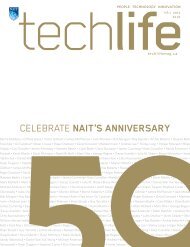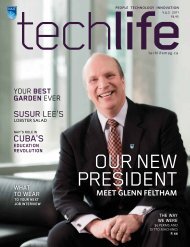CULINAITAt Edmonton’s City MarketDowntown, chef BlairLebsack checks out hisfavourites: (from top)Mighty Trio Organics oil,tomatoes from Gull ValleyGreenhouses and SmokyValley Goat Cheese.It’s no accident that Lebsack knows the peoplebehind the food. During nearly five years as executivechef at Madison’s Grill in the Union Bank Inn, a steadystream of farmers flowed through his kitchen, stockinga menu that always leaned local. He stands among agrowing subset of chefs who recognize that eating localis more than a fad – it’s essential.Eating local is not primarily about calculating thedistance from farm to table, Lebsack says, but aboutsupporting the “artisan and specialty farms thatshowcase what our land can actually produce.” Besidesupping the taste and nutrition quotient, eating localfuels our economy, reduces the energy consumed intransportation and, as today’s tour illustrates, buildscommunity.Reducing our reliance on faraway factory farms alsoincreases food security, Lebsack says. “Edmonton is thefarthest reach for California products, so if anything evergoes wrong in California, we’re the first to be cut out ofthe loop.”But only if we support these artisan farmers willthey continue to exist. Toward that end, Lebsack islaunching a local chefs’ collaborative aimed at matchingfarmers with chefs to help move more local food intorestaurants – no longer niche, but mainstream.as executive chef at the high-volume Shaw ConferenceCentre, Simon Smotkowicz has set a goal of doublinghis use of 10 per cent local food by the end of 2012.He knows the extra time involved, from scouting outsuppliers to preparing potatoes that no longer comepeeled. He also knows that this food typically costssomewhat more than mass-produced fare, althoughthat difference can be offset by choosing less popularcuts of meat and in-season produce. But dinersappreciate the results, he says. “It can be an edge for arestaurant, because these products are always muchbetter quality.”Yet only a minority of area chefs is dedicated tousing local food, says Smotkowicz, whose culinaryleadership earned him an honorary diploma fromNAIT in 2003. As president of the Canadian CulinaryFederation Edmonton Chapter, he is determinedto change that. It’s not a case of either-or, he says.“Because we eat local doesn’t mean we’ve got to sayno to everything else. It’s like being on a diet – usemoderation.”Noting that a chefs’ collaborative in Victoria issucceeding in putting more local fare on the menu,Smotkowicz imported the concept in collaboration withDine Alberta – and asked Lebsack to lead the charge.An initial meeting last November, hosted by AlbertaAgriculture, led to a producers showcase at Northlandsin February. More than 200 attended the showcase andthe buzz was encouraging, Lebsack says, but few chefschanged their buying habits. To overcome inertia, thecollaborative intends to build a list of local producersthat want to work with restaurants, he says. “We needto see some long-standing relationships, not just oneoffpurchases.”lebsack’s mid-summer farm dinner at Nature’s GreenAcres illustrates the dance involved in expanding theclientele for local food. The event is attracting quite acrowd, but expanding the table is not as straightforwardas it might seem. “We’re butchering one pig just for this,”Lebsack notes. It’s not as if killing another half pig is aviable option.The chefs’ collaborative faces that same issue writlarge when connecting chefs with potential suppliers,56 techlifemag.ca
Lebsack adds. “We have to be careful. The Ruzickasraise 20 animals a year; we can’t put them in contactwith the Shaw Conference Centre and the next thingyou know they’re all out of certain cuts and havenothing for the farmers market. It’s a fine balance.”Even for larger producers, weather and disease canwreak havoc on supply. One grower we meet says 70per cent of his crops remain to be planted due to rain;in previous summers, the issue has been drought. Butby working in concert, producers and chefs are findingways to ensure that what’s on the menu walks in thedoor in time to be served.Distributor Lori Menshik offers one such safetyvalve. Operating as Full Course Strategies from adowntown warehouse, she sources local food on behalfof chefs. “If I know I’ll have something on my menu forsix to eight months, she’ll make sure she has that onhand,” Lebsack says.Farmers are also partnering up to do business involume. Edgar Farms has a stall at the market today tosell asparagus, its specialty. But the farm is also part ofthe Innisfail Growers Co-operative, whose five familieshave banded together to attend more markets – andattract larger accounts.Some producers have grown so large andsophisticated that they could dependably supply ourentire region, Lebsack says. He points to Kuhlmann’sMarket Gardens and Riverbend Gardens as primeexamples of operations that “run like clockwork,” growfantastic crops and sell some of it all year thanks togreenhouses and climate-controlled storage. Theirexcess goes to large grocery chains to be shipped whoknows where, he notes. Ideally, this food would staycloser to home, replacing shipments from afar.The chefs’ collaborative aims to address volumeissues by matching users with right-size suppliers. “Sayyou’re using all prime cuts and someone else is makingburgers,” Lebsack says. “Why don’t you team up towork with these suppliers, so farmers are not butcheringanimals and being left with too much ground beef?”Hank Strokappe (Retail Meatcutting ’05) ofFarm Fresh Lamb offers a case in point. He swore offrestaurants after dealing with some high-handed chefswho wanted nothing but prime cuts – at a discount. Yethe now supplies four Edmonton eateries. What makesit work? Creativity. “They’re not afraid to cook withdifferent cuts.”Part of the onus lies with suppliers, Strokappeadmits. “When I first started cutting shoulder steaks,they didn’t sell. But now we do boneless stewing meat,which works well in curries, and we do up a bonelessshoulder roll with netting. So we’re more creative in howwe market the cuts.” He credits NAIT instructors withlaying the foundation. “They drilled into us that a jobworth doing is worth doing right.”like a growing number of consumers, NAIT instructorHong Chew (Culinary Arts ’93), the Canadian CulinaryFederation Edmonton’s Outstanding Member of theYear for 2011, wants to know not only where but howthe food was grown, harvested, stored and shipped.“I don’t specifically follow the 100-mile diet, althoughmost of the things sold at farmers markets come fromwithin 100 miles,” he says. Noting that British Columbiaberries, fruit and seafood greatly expand our menu in ashort-summer province whose winter fare leans to rootvegetables, he adds, “I believe food should transcendprovincial borders, and I’m a big supporter of anythingCanadian. We have so much to offer from the Canadianperspective in terms of food – coast to coast and northto south.”Recognizing NAIT’s role in equipping the nextgeneration of chefs to cook local, both Chew andLebsack are making a point of injecting local fare intothe curriculum. Ernest’s, the dining room where culinaryarts and hospitality management students cut theirteeth, now uses 30 per cent local fare and is aiming for50 per cent, Chew says. “We’re doing it gradually inbaby steps, trying to switch key products over.”Incoming students are fueling the shift, Chewadds. His colleagues are interested as well, but manyare focused on covering set curriculum rather thanscouting out local producers. As a culinary managementinstructor with a focus on procurement, he’s in a perfectposition to shift buying patterns by taking studentsto area farms and inviting producers such as honeyproducer Lola Canola’s Patty Milligan to campus. “Pattyis a great educator, just passionate about what shedoes,” he says. “That’s what you want to see from alocal standpoint.”Indeed, featuring the people behind the food is oneof the keys to promoting local, Chew says. “When weput a certain product on the menu, there has to be astory behind the product. That’s how you educate theconsumer about where the food comes from.” And iflocal is what consumers demand, he adds, “Guess what,there will be a lot more local produce.”like many vendors at that Saturday market, Alan Irvingis expanding carefully while refusing to compromisequality, producing pork products that my tour guidedeclares “absolutely phenomenal.” In fact, Irvings FarmFresh stands as “one of the models” of healthy growth,says Lebsack, who has visited to help stuff sausages andwatch the family in action.“There are a lot of really good success stories outthere,” Lebsack adds. “Right now, the producers aredoing a better job than the chefs. They’re offering allthese really good things, but we’re not buying enough.We need to see more of it on our menus.”“Because we eatlocal doesn’tmean we’vegot to say noto everythingelse. It’slike being ona diet – usemoderation.”– Simon Smotkowiczexecutive chef, ShawConference Centrev5.1 2011 57










